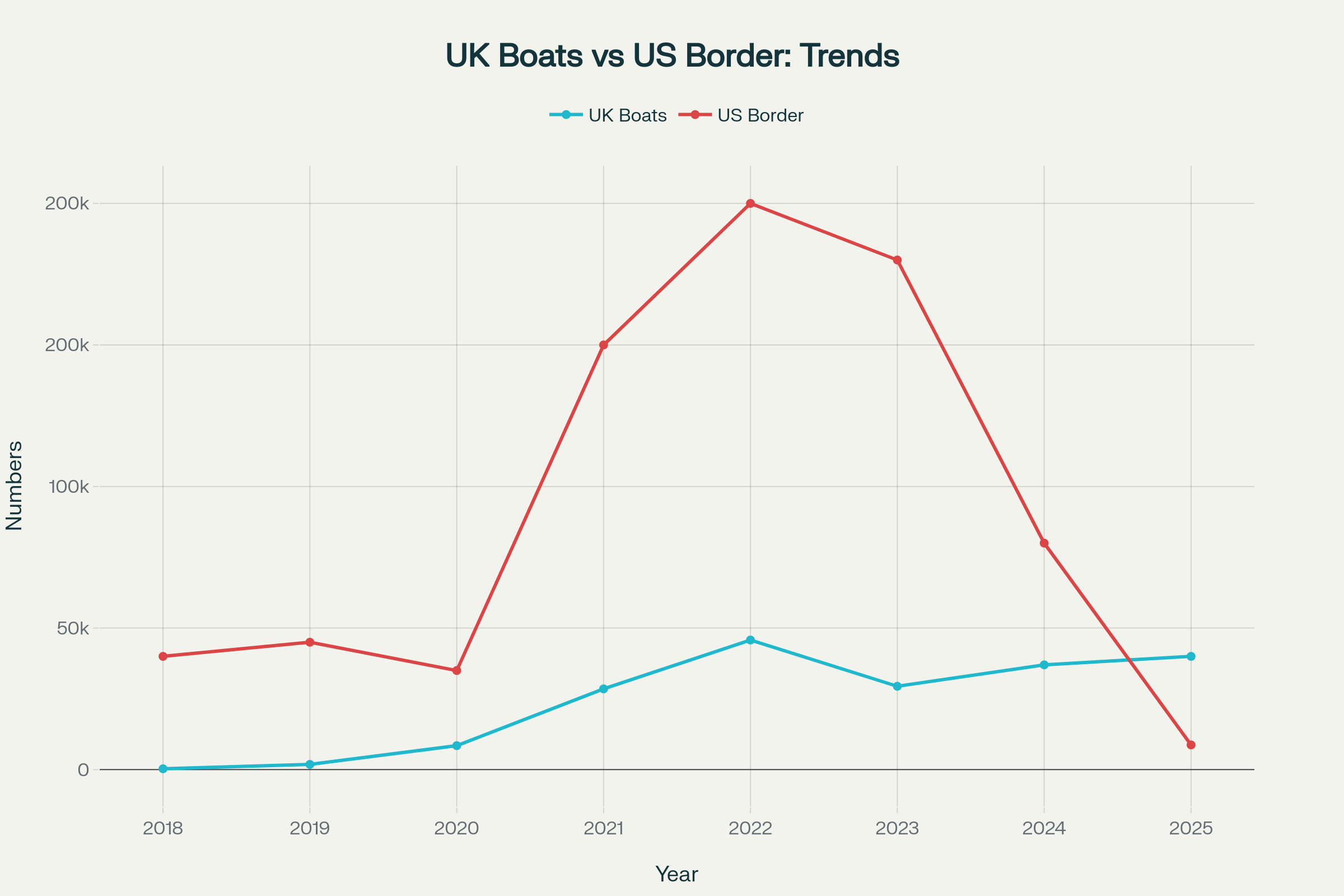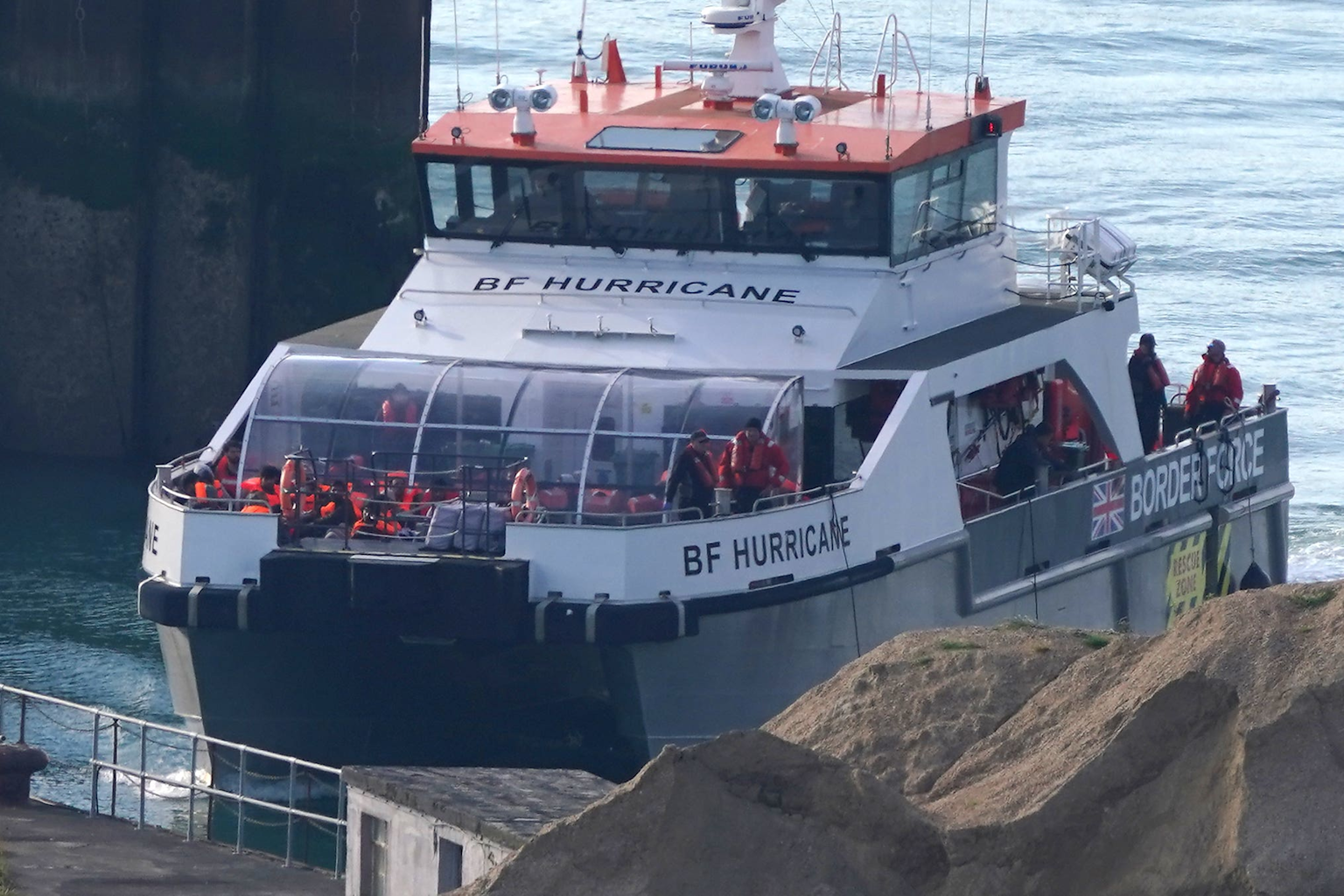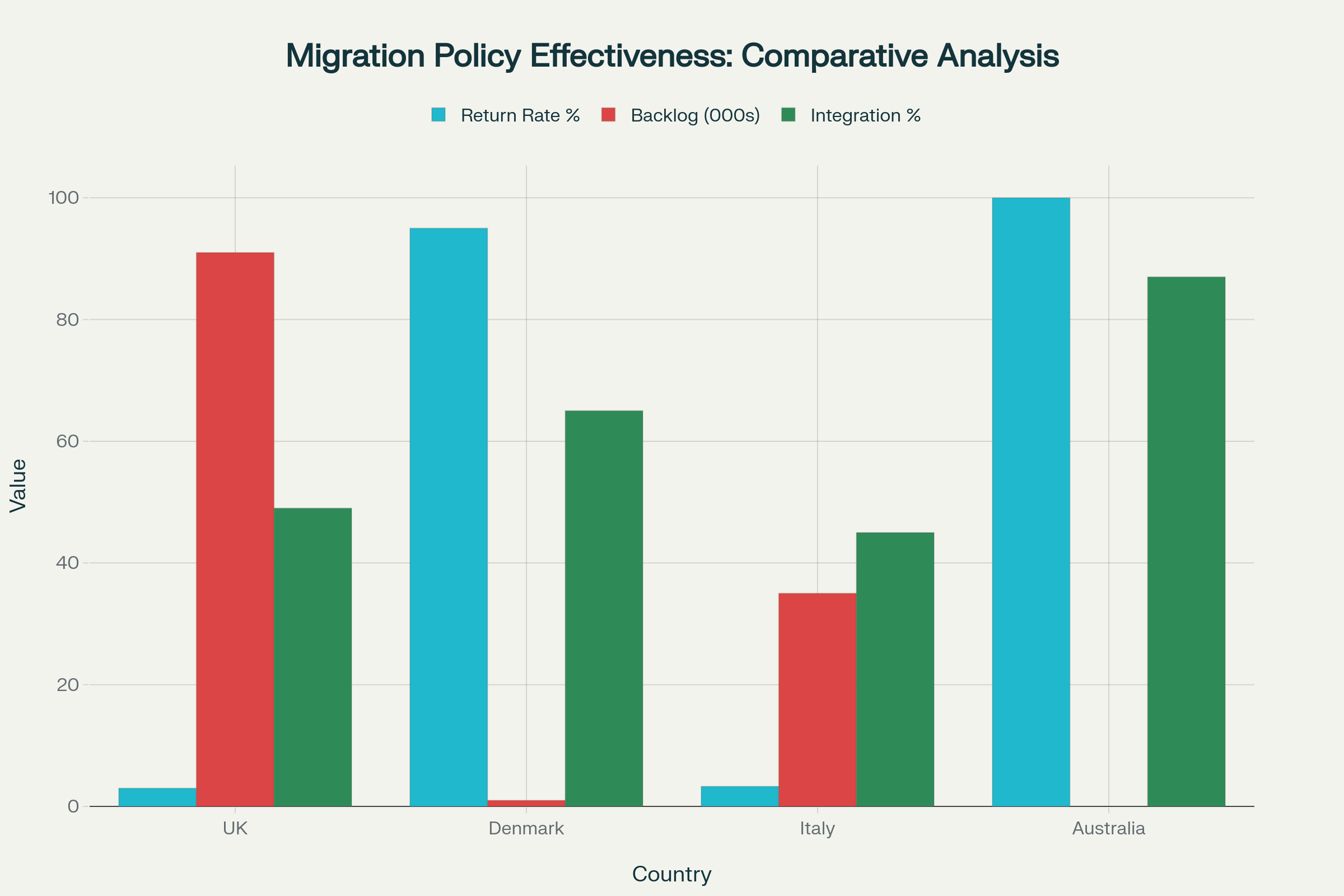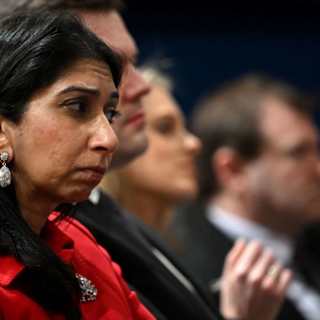UK Migration Crisis – What’s Going Wrong and Why Trump’s Claims Matter
Right, let’s get straight to brass tacks here. As someone who spent two decades dealing with the consequences of failed policies on the streets, I can tell you this migration shambles isn’t just a political football – it’s a national security crisis that’s been brewing for years while politicians played games.

Comparison showing UK small boat arrivals trending upward while US border encounters declined dramatically, particularly in 2025
The Stark Reality: UK vs US Border Performance
The numbers don’t lie, and they paint a damning picture of UK incompetence versus American effectiveness. While Trump’s administration reports zero illegal releases into the US interior for four consecutive months and a 93% decrease in border encounters (from 117,905 in May 2024 to just 8,725 in May 2025), the UK is seeing the exact opposite trajectory.

A UK Border Force patrol vessel ‘BF HURRICANE’ involved in English Channel operations to manage migrant crossings
Our small boat crossings increased 25% in 2024 to 37,000 people, and the first half of 2025 saw 20,000 arrivals – already 48% higher than the same period in 2024. This isn’t just a statistical failure; it’s 73 confirmed deaths in 2024 alone – more than all previous years combined.
The Rwanda Debacle: £700 Million Down the Drain
The Border Security, Asylum and Immigration Bill officially repealed the Safety of Rwanda Act in 2025, closing the book on what can only be described as one of the most expensive policy failures in recent memory. £700 million spent, four voluntary relocations achieved. Let that sink in – that’s £175 million per person who actually went to Rwanda voluntarily.
The legal framework was fundamentally flawed from the start. The Supreme Court ruled it unlawful because Rwanda wasn’t safe, forcing the government into the constitutionally extraordinary position of legislating that a country was safe regardless of actual conditions. As one former Supreme Court judge noted, this was “constitutionally really quite extraordinary”.
The Post-Rwanda “Replacement”: More of the Same Problems

Comparative analysis showing Denmark and Australia’s stricter approaches achieve higher return rates and lower backlogs
The UK’s replacement strategy centers on the new Border Security Command with £100 million in funding and 300 additional National Crime Agency officers. But here’s where the government’s own data exposes the fundamental problem: only 3% of small boat arrivals since 2018 have been returned. That’s 5,000 out of approximately 160,000 people.
The Returns Crisis
The UK returned just 35,000 people with no right to remain in its first year under Starmer – a 13% increase that sounds impressive until you realize it’s still a fraction of new arrivals. With 37,000 small boat arrivals in 2024 alone, plus standard asylum applications reaching a record 108,000, the mathematics of enforcement are stark.
The new UK-France returns agreement, operational since August 2025, represents the government’s main hope. Under this “one-in, one-out” scheme, the UK can return small boat arrivals to France within three months, accepting an equal number through legal routes. The first return occurred in September 2025, but initial pilot phases suggest around 50 returns per week – hardly game-changing numbers.
What the UK Is Doing Wrong: A Systematic Failure
1. Processing Incompetence
The asylum backlog peaked at 132,000 in 2023 and remains at 91,000 despite government efforts. Average processing time exceeds 413 days, with 50% of initial decisions overturned on appeal – clear evidence of poor quality initial assessments.
2. Detention and Accommodation Crisis
The government closed over 200 asylum hotels from a peak of 400, but this reduction came at the cost of expanded detention capacity with 1,000 new beds at Campsfield and Haslar. The hotel system was costing £9 million daily at its peak.
3. Legal Framework Chaos
The immigration system lacks coherent design, operating through “a cobbled-together conglomeration of incomprehensible and outdated laws, criteria that are set out in constantly shifting so-called ‘rules'”. This complexity creates opportunities for gaming the system while frustrating legitimate cases.
4. Border Security Theater
Despite increased patrols and technology, smuggling gangs have adapted faster than enforcement. The NCA achieved 351 disruptions of organized immigration crime networks in 2024-25 – a 40% increase – yet arrivals still rose. This suggests disruption without deterrence.
Why Trump’s Approach Works: Lessons the UK Ignores
The US success builds on several factors the UK has failed to implement:
1. Mexican Cooperation
Mexican authorities recorded more migrant encounters than US Border Patrol for months during 2024-25, intercepting potential crossers before they reached the American border. The UK lacks similar cooperative arrangements with France for upstream intervention.
2. Deterrent Messaging
Trump’s administration achieved a 97% reduction in Central American northbound migration through clear messaging that entry was “impossible”. The UK’s mixed messages about legal routes and humanitarian obligations undermine deterrence.
3. Operational Continuity
Crucially, current US success builds on Biden administration policies from 2024, including the CBP One app system and enhanced Mexican enforcement. The Trump administration inherited momentum rather than creating it from scratch.
4. Resource Commitment
The US deployed 10,000 service members and spent $376 million on military support by March 2025. UK border security funding, while increased to £100 million, pales in comparison relative to the scale of operations required.
International Comparisons: Effective Models the UK Could Learn From
Denmark’s Zero Asylum Approach

Denmark granted only 400 asylum applications in 2024, down from thousands previously. Their success comes from:
Upstream processing as close to origin countries as possible
Integration requirements including 37-hour work weeks for benefit recipients
Financial incentives for voluntary return (DKK 20,000 within two weeks of refusal)

A formal parliamentary session potentially discussing UK migration laws, with key figures blurred for privacy
Italy’s Three-Pillar Strategy
Italy achieved a 60% reduction in sea arrivals in 2024 through coordinated “externalization, criminalization, legalization” policies:
- Libya partnership with Coast Guard training and €57.2 million EU funding
Albania processing centers for offshore asylum determination
Expanded legal migration channels with 165,000 new work permits
However, Italy’s deportation rate remains at only 3.3%, exposing the same fundamental weakness as the UK.
Australia’s Pacific Solution
Australia’s offshore processing policy cost AUD $7.6 billion for 3,127 transfers since 2013, but virtually ended unauthorized maritime arrivals. The policy succeeded in “stopping the boats” but at enormous financial and reputational cost, with 86.7% of processed asylum seekers ultimately recognized as refugees.
The Current Government’s Capacity for Change: Prognosis Poor
Starmer’s administration faces the same structural problems that defeated previous governments, compounded by several factors:
1. Legal Constraints
The UK remains bound by European Convention on Human Rights obligations that Trump’s administration doesn’t face. Starmer has explicitly rejected any departure from ECHR oversight.
2. Capacity Limitations
Despite recruitment drives, Immigration Enforcement received over 150,000 job applications but actual deportation capacity remains limited by detention space, charter flight availability, and receiving country cooperation.
3. Political Constraints
Labour’s traditional voter base includes pro-immigration constituencies that constrain policy options. Starmer’s “firm but fair” rhetoric attempts to balance contradictory demands.
4. Judicial Interference
Courts continue to block removals through last-minute injunctions. The Home Secretary has already indicated plans to limit appeal time frames and review modern slavery legislation to prevent “misuse”.
The Hard Truth: Systemic Change Required
The fundamental problem is that the UK operates an immigration system designed for a different era. The 1951 Refugee Convention framework assumes state-controlled migration flows and orderly processing – assumptions that organized criminal networks have systematically exploited.
Effective solutions require acknowledging uncomfortable realities:
- Deterrence requires credible consequences – the current 3% return rate makes crossing attempts a rational gamble
- Legal migration channels must expand to undercut smuggling demand while maintaining public support
- Regional partnerships are essential but require offering tangible benefits to transit countries
- Constitutional constraints may require fundamental reform of international obligations
The Danish model offers a template, but implementing it requires political courage the UK government has yet to demonstrate. Trump’s success, meanwhile, builds on geographic advantages (Mexican cooperation, existing barriers) and political will for enforcement that transcends party lines in America but remains contentious in Britain.
Conclusion: Crisis Management vs Crisis Resolution
The UK isn’t solving its migration crisis – it’s managing it badly while costs spiral and public confidence erodes. Trump’s administration inherited declining numbers and maintained momentum through clear messaging and sustained enforcement. The UK inherited rising numbers and lacks both the political will and operational capacity for decisive action.
Without fundamental reform of legal frameworks, massive expansion of detention and processing capacity, and credible deterrent policies, the UK will continue seeing increasing arrivals while other countries that adopt harder lines see reductions. The mathematics are inexorable: reward a behavior and you get more of it.
The question isn’t whether the current government can address this crisis – it’s whether British democracy can survive the consequences of continued failure. As someone who spent decades watching policy failures play out on the streets, I can tell you that public patience isn’t infinite. The electoral consequences of this ongoing shambles will be severe, and deservedly so.
Sources: Analysis based on official government statistics from UK Home Office, US Customs and Border Protection, Migration Observatory at Oxford University, and comparative policy research from European migration agencies.

